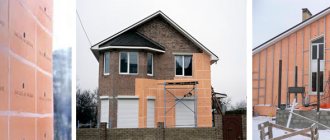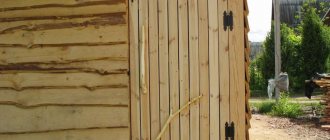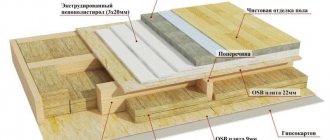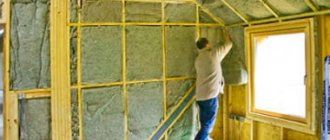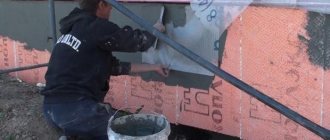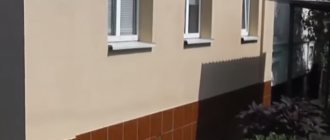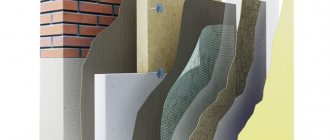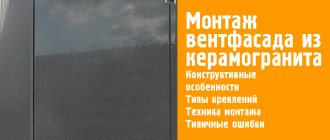There are many types of insulation materials and several methods of insulation. They differ in properties and level of microclimate preservation. It is important to choose coatings that are cheap, have good characteristics, and are easy to install.
Stone wool for facade insulation is an excellent choice. Fiber products occupy up to 70% of the insulation market. The material and methods of its use will be discussed in the article.
Insulation process
Scope of application of mineral thermal insulation
The range of use of insulation made from various types of mineral wool is very wide. This material is used both in construction and in industry, in the manufacture of products intended for insulating surfaces with heating temperatures up to 700° C, in the production of sandwich panels and other products of various functionality.

Insulation of walls with mineral wool using a frame
In the construction industry, mineral wool is used to insulate structural elements of buildings and structures for any purpose:
- walls;
- floors:
- floors;
- basements;
- facades, both ventilated and plastered;
- plinths;
- pitched and flat roofs;
- balconies and loggias;
- frame houses;
- temporary structures - sheds, cabins, etc.
In engineering communications systems, mineral wool with various technical characteristics and properties is used for insulation of main and autonomous water supply pipelines laid underground and on the surface, local and main sewerage systems.
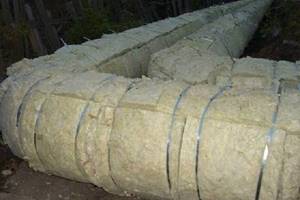
Insulation of main pipelines with mineral wool
Mineral wool insulation has also found its application in the construction of three-layer walls made of brick or stone, as a middle layer, as well as in the production of reinforced concrete structures, significantly increasing their thermal insulation properties.
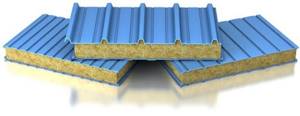
Use of mineral wool in sandwich panels
Mineral wool is also used in various industries - oil and gas, metallurgical and energy.
Insulating a house with mineral wool
Any owner can insulate the facade of his house using high-quality mineral wool, even if he does not have the skills to perform construction work.
It is important to do the work progressively, following a certain technique. The installation plan looks something like this:
1) First you need to thoroughly clean the walls of debris, dirt and dust. If there are oil stains, they also need to be removed - degreased. Inspect the walls and if there are chips, cracks, or significant depressions, they must also be removed - plastered and sanded with a sander.
2) Surface treatment with a primer. It is not necessary, but it is highly advisable to prime the surfaces to be treated with a deep penetration primer with antifungal additives. It will prevent the development of dampness and fungus in the wall of the building.
3) Next, prepare the adhesive solution. For mineral wool, it is best to use special glue - it is sold dry and sold packaged in bags. Before use, it must be diluted with cold water according to the recommendations given on the package.
Important: mix the glue thoroughly until a homogeneous solution of the desired consistency is obtained. It is most convenient to stir the adhesive mixture using a construction mixer attached to a hammer drill
4) The process of attaching mineral wool to the facade. For even fixing, it is worth taking care to set the level before starting work.
Pay special attention to the joints - they should be minimal, it is best if the slabs or mats sit close to each other. The glue must be applied evenly over the entire surface of the insulation; an ordinary small spatula is suitable for this.
In addition to the adhesive mixture, you will also need plastic dowels, they are also called “fungi”. Without them, the cotton wool, which is quite heavy, may simply fall off.
5) The next important stage is reinforcing the mineral wool with mesh. This must be done, since this layer prevents linear expansion of the insulation, leading to its delamination. For reinforcement, a special mesh is required that is resistant to alkaline solutions. You need to attach it to the insulation using an adhesive solution. When this layer “sets”, another layer of glue will be needed on top - it will visually level the wall and completely cover the reinforcing mesh.
6) And the final stage is decorative finishing. In this case, the simplest option is decorative plaster or painting the walls with textured paint.
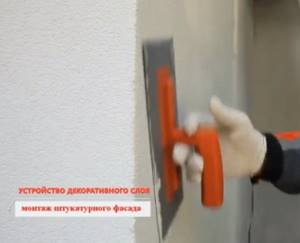
What's happened
In modern construction, several types of insulation with a characteristic fibrous structure made from mineral raw materials are used:
- basalt wool;
- glass wool;
- slag.
We will look further at what the first two types of insulation are.
Mineral wool
Mineral wool is produced from waste from the glass industry: broken glass (80%) and a mixture (20%) of quartz sand, dolomite flour, borax, soda and limestone (by changing the mixture recipe you can obtain different mechanical properties of the insulation). All this melts at a temperature of about 1400oC in a furnace. The molten mass is blown under high pressure through a special grate, resulting in the formation of very thin staple-type fibers (short).
The resulting glass threads are fed to a conveyor, where a layer of glass wool is formed. Here, a binder is fed into the “carpet”, which, when the temperature drops, catalyzes polymer bonds between the thinnest fiberglass strands. The output is bright yellow, frozen glass wool.
It can be sold in the form of a roll or slabs obtained using cutters and saws from a continuous strip of fiberglass.
For insulation:
- fiber diameter - 3-15 microns, length - 15-50 mm. Moreover, the longer the fibers, the higher the strength and elasticity of the slab or tape;
- thermal conductivity coefficient - 0.038-0.046 W/(m×°K);
- resistance to high temperatures - can withstand up to 450oC.
Thanks to these characteristics, mineral wool is widely used in various fields of industry: in construction - for insulating horizontal, vertical and inclined surfaces in a building structure, in industry - for thermal insulation of pipelines, tanks and furnaces.
More detailed information, with technical characteristics, about glass wool can be found in the work “Mineral wool for insulation”.

Basalt wool
Basalt insulation is made from basalt and gabbro (a type of granite) by melting the rocks and then blowing the resulting liquid lava through grates with small holes. The result is a loose layer of material with randomly arranged fibers (for certain brands of insulation, the arrangement is changed from chaotic to vertical). It can be found on sale in the form of slabs and rolls, but no more than 6 m long.
Technical characteristics are similar to those of glass wool:
- thermal conductivity - 0.035-0.042 W/(m K);
- average diameter of threads - 4-12 microns;
- fiber length up to 16 mm.
The insulation can be used at temperatures from –190oC to +1000oC. Does not burn. Does not absorb water - hygroscopicity is practically zero (not even a tenth of a percent).
In addition, basalt wool has good sound insulation properties. Therefore, it can be found in recording studios on the walls and ceiling as a sound insulator.

Rockwool is a world leader
Rockwool was founded in 1909 and is still headquartered in Denmark. For almost 110 years of its existence, the company has become a leader not only in the European, but also in the global thermal insulation market. It now has 28 factories in North America, Europe and Asia. In Russia there are three enterprises in the Moscow, Chelyabinsk and Leningrad regions. Another plant operates in Tatarstan. The total number of employees of the company reaches 10,000 people.
The product range contains materials for insulation and fire protection, as well as sound insulation in domestic and industrial premises, ships, and oil rigs. This company was the first in the world to be awarded the Eco Material Green environmental safety mark, so its products are very popular for insulating bedrooms and children's rooms.
Rockwool stone wool for private houses and apartments
For private housing construction, the manufacturer has a whole line of stone wool insulation. The most popular among them are insulation materials such as:
- LIGHT BUTTS
- SAUNA BUTTS
- ACOUSTIC BUTTS
LIGHT BATTS are lightweight mineral wool slabs designed for thermal insulation of non-load-bearing structures in the insulation system of a house or apartment. The thermal conductivity of this insulation is 0.036 W/(m K). It can be used to insulate a large number of objects: attic rooms (pitched roofs), partitions, joist floors, walls lined with siding, frame walls, balconies, baths, saunas
SAUNA BATTS are basalt slabs with a density of 40 kg/m3 and can be used both on the ceiling and on the walls. A special feature of the insulation is its one-sided coating with aluminum foil, which does not allow steam and water to pass through. This protects the fibers from getting wet and shrinking, and also completely blocks the escape of heat from the room. Using such cotton wool in a bath or sauna will ensure the preservation of temperature and the integrity of the partitions. In this case, installation of a vapor barrier is not required, which reduces construction costs. The material can withstand up to 200 degrees without loss of properties.
ACOUSTIC BATTS stone wool has a pronounced sound absorption effect, therefore it is optimal for insulating walls and ceilings in an apartment, which ensures comfort and increases fire safety. Suitable for all types of residential and non-residential premises, installation in suspended ceilings is permitted. The sound absorption index with a layer of 50 mm is 0.8 according to GOST 23499-2009. A thickness of 200 mm provides sound absorption class A with an index of 1.0. The density of such basalt slabs varies from 35 to 45 kg/m3.
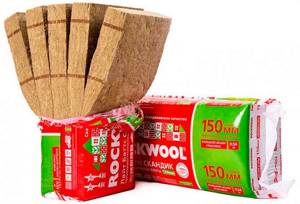
Rockwool LIGHT BUTTS.
Rockwool stone wool for facades
Insulation of facades requires durable slabs that will interact well with subsequent finishing materials. For this purpose, Rockwool produces VENTI BATTS N OPTIMA, with the function of repelling water thanks to synthetic binders. The main material is fibers from basalt rocks, which provide high insulation and strength.
In terms of density, VENTI BATTS N OPTIMA stone wool has an indicator of 32 kg/m3 and is not prone to destruction under the influence of its own weight and emphasis on attachment points. Thermal conductivity is 0.036 W/(m*K). The material does not burn at all, which protects the building when trying to set fire to the facade. The thickness of the slabs varies from 50 to 200 mm and is selected according to insulation needs.

Rockwool VENTI BUTTS N OPTIMA.
Stone wool for roof insulation
Roof insulation must withstand the heavy weight of subsequent layers and precipitation, so increased demands are placed on them.
The manufacturer Rockwool has a wide range of products for roof insulation, both flat and complex shapes:
- ROOF BATTS N LAMELLA - as the name implies, it is produced in the form of lamellas or strips, which is convenient for installation on roofs of various shapes. Installation with dowels or glue is allowed. Produced only with a thickness of 200 mm. It has a high density of 115 kg/m3, so it can withstand up to 5500 kg of pressure per square meter.
- ROOF BATTS D OPTIMA - made with two layers (hard outer and regular), which increases strength and reduces weight. Thicknesses range from 60 to 200 mm. The hard layer is always 15 mm. The density of the outer side reaches 205 kg/m3, and the inner one 120 kg/m3.
- ROOF BATTS N OPTIMA - designed for organizing the lower layer of the roof with subsequent laying of more durable materials. The density is 100 kg/m3, and the thermal conductivity is 0.036 W/(m*K). Thickness ranges from 40 to 200 mm.
- ROOF BUTTS IN OPTIMA are especially durable slabs with a density of 160 kg/m3 (full thickness), intended for laying as the last layer before the main roofing material. The plates are hydrophobic and insulate not only from freezing temperatures, but also from moisture penetration.
- SANDWICH BUTTS K - designed for use as a middle layer in sandwich panels. They can be located immediately behind the metal shell. Rigidity allows you to withstand the pressure of atmospheric precipitation. Density is 140-155 kg/m3. Compression can withstand forces up to 10,000 kg/m2.
- ROOF BUTTS IN EXTRA - slabs are produced with a thickness of 40-50 mm and serve as the top layer in the construction of the roof. The density of the entire material is 190 kg/m3.
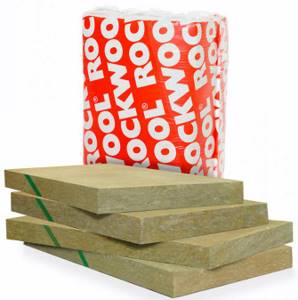
Rockwool ROOF BUTTS.
Tips for choosing
Thermal insulation wool must be of high quality so that it can be used to safely insulate the house from the outside
To find the most suitable option, you should pay attention to various manufacturers of this material. German quality Ursa, Isover, Rockwool is considered the best
When choosing the appropriate option, you should pay attention to the relationship between price and density of mineral wool.
If you want to buy cheaper options for glass wool and slag wool, then you should not rush, because these materials have low sound insulation, and in addition, they cannot retain heat as well as mineral wool. Installation is also more difficult, because working with glass wool is very dangerous, especially in the wrong hands.
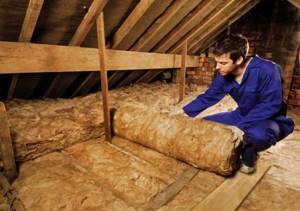
When choosing the highest quality material for wall insulation, you should give preference to mineral wool, but this material also has its own characteristics.
It is important to find out in which direction the fibers are located: in a vertical position, the product will better store heat and insulate from excess noise. With a dynamic arrangement of fibers, cotton wool acquires more durable characteristics and is able to withstand heavy loads.
It is worth paying attention to whether there is a GOST mark on the packaging, which will also say a lot about the manufacturing technology of the product. If we are talking about mineral wool slabs, then they are declared according to GOST 9573-96, and in the case of pierced mats it will be GOST 21880-94, as for PPZh slabs, the value will be equal to GOST 22950-95.
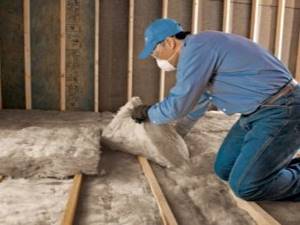
When planning to decorate the interior with mineral wool, you need to take care of the correct dimensions of the material. All indicators must exactly correspond to those indicated on the packaging, so it is better to personally measure everything, especially the thickness of the product, on which the quality of the entire repair will depend.
Insulation can be used not only for walls, but also for covering the ceiling, and sometimes the floor. If a non-residential space, such as an attic or basement, needs to be made suitable for full or partial occupancy, then the placement of thermal insulation boards cannot be avoided. The roof is insulated in the attic, and the basement is insulated, which helps create optimal living conditions with minimal effort.
Advantages of a wet façade
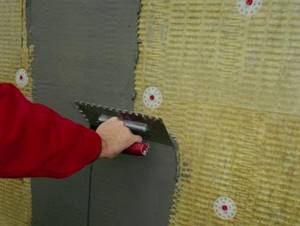
In modern construction practice, wet facade technology has long been economically justified. Today, the pricing policy has been increased for almost all materials, so all developers are looking for an option on how to achieve a good effect at a low cost. This technology has gained popularity due to its good thermal stability, which allows you to save money during the heating season. This construction method will also allow you to achieve the following positive characteristics:
- Will reduce air conditioning or heating costs by approximately 50%;
- With the help of mineral wool, you can not only reduce the weight of the facade, but also the total cost of construction;
- The size of rooms, thanks to wet technology, can be increased by 5%;
- The wet facade method can be rationally used for any materials and exterior finishing;
- The installation work is very easy, so you can do it yourself.
- Such thermal insulation has a positive effect on the service life of the building;
- If you choose the right insulation parameters, you can reduce the risk of deformation of external walls from exposure to temperatures;
- The technology also eliminates the problem of thermal insulation of interpanel seams.
What are the disadvantages of mineral wool?
Although stone wool fibers do not splinter, tiny pieces of them can still rise into the air, like dust. There is a danger of inhaling them, which is not at all good for health. There is another danger - the formaldehyde resin included in this material can poison us with the phenol that is released from it. But these troubles can be completely avoided if you follow safety precautions.
First of all, do not forget to wear a respirator when working with mineral wool. And also cover the insulation plane over the entire surface with a vapor-proof polyvinyl chloride film. As for phenol, at room temperature it will not be released from mineral wool. Naturally, if you purchase material from a good manufacturer.
True, when the material is heated to a temperature above the limiting temperature, phenol still gets out of control. What to do in this case? Try not to allow the insulation to heat up so much. If this is excluded, then take the more expensive, but absolutely safe, super-thin basalt fiber. No phenol will be released from it. Whatever you choose, try to buy products from a reliable large brand - in this case, the actual technical characteristics of mineral wool will strictly correspond to the declared ones.
Mineral wool for facade plaster | Classification
1. Basalt mineral wool for plaster, density 130-150 kg/m3 (basic density - 145 kg/m3). Classic mineral wool insulation for facade systems with a finishing plaster layer. Only this density is included in the testing of façade system manufacturing companies. There are no restrictions on use.
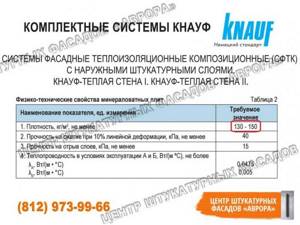
2. Basalt mineral wool for plaster, density 90-129 kg/m3 . Lightweight insulation as a result of savings for corporations on production and consumers. Currently, manufacturers not only manufacture such products, but also vying with each other to advertise such a solution as “Optimal”, “Effective”, etc. The insulation has a reduced strength to peel off layers. Restrictions on the use of insulation are in areas with low wind loads, on buildings with a limited number of storeys.
3. Mineral glass wool for plastering work. Low-quality insulation, characterized by low tear strength of layers and a tendency to deformation in facade systems. Problems with cracking of the plaster layer! Having learned from our own experience, the Center for Plaster Facades AURORA does not recommend the use of such insulation in plaster systems and does not provide a guarantee for such work.
Facade mineral wool | Main distinctive characteristics
1. Density indicator - the overall integrity of the façade system and resistance to deformation and external influences. Density is directly proportional to the tear strength of insulation layers! It is worth noting that recently the density has been reduced without changing the peel strength, i.e. equipment in factories costs the same, but the numbers on paper become more beautiful.
2. Cleanliness of cotton wool . Low or variable quality control (lower cost of production) results in significant defects: solid inclusions of basalt rocks that are not stretched into fiber (“curlings”), as well as inclusions of unmelted binder clumps. When air masses pass through these defects due to moisture transfer in the wall structure from the inside to the outside, rusty spots (“phenolic spots”) appear on the surface of the facade.
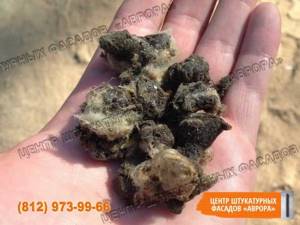
3. Dusty cotton wool . A fairly important indicator, but insignificant if the installation is carried out by professional workers. According to technological regulations, facade wool must be processed with “vacuum cleaners” to remove dust from the surface of the slabs after cutting, which is not done by all manufacturers in order to save money. Dust directly affects the degree of adhesion of adhesive mixtures to the insulation, so an experienced specialist will shake off the dusty insulation vertically with a short but energy-intensive vertical blow and more thoroughly prime it with the adhesive mixture.
Features of thermal insulation of ceilings with cotton wool
Mineral wool is considered a good insulation material for ceiling cladding. The building material is suitable for use both in the attic and in living spaces.
The following components can serve as raw materials for the production of mineral wool:
- broken glass;
- sand;
- blast furnace slag;
- basalt rocks.
Mineral wool is the most common building material used for insulating ceilings. The following types of mineral wool can be used for wooden houses:
- slag wool;
- glass wool;
- stone or basalt wool.
However, many owners of private houses continue to use mineral wool to insulate the ceiling area. This is due to the fact that this type of building material has many advantages over analogues, but the list of disadvantages is small. A good level of thermal insulation is achieved by using thin mineral wool boards with a foil coating. Such insulation almost does not hide the free space, is fire resistant and does not allow heat to escape from the room, reflecting it back.
Advantages of ceiling insulation with mineral wool
Thermal insulation material such as mineral wool has a whole list of advantages:
- The minimum thermal conductivity coefficient allows you to maintain a comfortable temperature in the room throughout the year.
- Installation of the material is extremely simple, which allows you to carry out the work not only with the involvement of professionals, but also with your own hands. This has a positive effect on the overall cost of repairs.
- Availability of building material - the cost of mineral wool is significantly lower than that of similar insulating materials.
- Mineral wool does not support combustion, withstanding temperatures up to 1000 degrees Celsius.
- Mineral wool fits into all hygiene standards in force today and is a natural material.
- The insulation provides excellent sound insulation.
- The material is resistant to chemicals and microorganisms.
Disadvantages of installing mineral wool on the ceiling
Despite the impressive list of advantages, the material also has significant disadvantages:
- Low quality materials most often contain toxic substances and are unsafe for human health.
- The porosity of the material is high, which negatively affects its strength.
- Compared to polystyrene foam, the weight of the insulation is quite significant, which can create difficulties with arranging the insulating layer from the inside.
- You can work with the material only if you use protective equipment for your eyes, hands, and respiratory organs.
- The heat insulator is exposed to moisture, which significantly deteriorates its basic qualities.
How to buy DiROCK mineral wool for a wet facade
DiFerro company provides a full range of services from production to installation of basalt slabs. We are ready to fulfill your order in a short time, competently planning the entire production process. We are not afraid of difficulties and happily take on unusual projects, working with even the most demanding and extraordinary customers.
We guarantee
:
- Optimal prices for DiROCK products
- Raw material quality control
- Certified product quality
- Timely implementation of complete deliveries
- Honesty and openness in relations with the customer
We invite general contractors and developers, architects and designers, construction and installation organizations and suppliers of technological solutions, as well as distributors of building materials and DIY networks to cooperate. For each client, our specialists will select the optimal solution to the production and delivery of DiROCK products.
Contact us to find out all the details and learn more about cooperation with DiFerro.
Review of insulation materials
Penoplex
Masters have opposing opinions about it. Some people consider this type of thermal insulation to be the most effective that exists. Some, on the contrary, are sure that polystyrene foam has no place on facades.
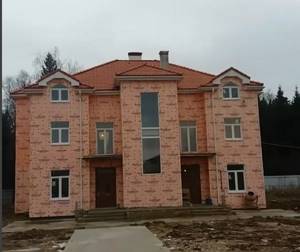
Photo: Instagram nadegniy
One of the arguments in favor of this is that Penoplex has a paraffin-polymer film on its surface, which prevents good adhesion to finishing materials. Therefore, decorative finishing can quickly “fly”, especially if the surface of the penoplex is not sealed before plastering. They blame him for both moisture resistance and the greenhouse effect in the house. This is really a disadvantage that should be smoothed out by a well-designed ventilation system.
Photo: penoplex.ru
Defenders of Penoplex claim that there are special plaster mixtures that contain substances that penetrate well into the structure of the material.
Among its positive properties are low thermal conductivity, safety for human health, strength (a car can drive over penoplex without leaving visible damage), resistance to microorganisms, long service life and the same 100% moisture resistance: EPS completely blocks the entry of moisture from the outside .

Photo: Instagram domfasad.kz
Styrofoam
A close brother of penoplex, they are made from the same raw materials, but using different technologies. Polystyrene foam is very fragile, does not “breathe” at all, is capable of absorbing a lot of moisture and quickly deteriorates in the sun if it is not covered with anything. However, it is good in its own way: cheap, lightweight, absorbs noise, protects from the cold and is easy to install.
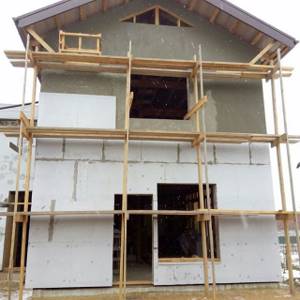
Photo: Instagram vankevich_siarhei
But it is absolutely not suitable for wooden houses: they can begin to rot. And if you live near fields where many rodents live, it is better to consider other insulation materials: mice love to live in polystyrene foam.
For facades, you need to use material that has a “talking” marking with the letter “F”.
Mineral wool
It can be stone (made from granite, basalt, porphyrite), slag (metallurgical waste) and glass (residues from glass production, plus soda, limestone, dolomite and borax).
Stone is a favorite because it gives high-quality and durable results, and is considered the most environmentally friendly of all, although it contains phenolic binders.

Photo: Instagram fasady_belarus
Slag is more often used to insulate sheds and garages than houses, since its service life is not very long.
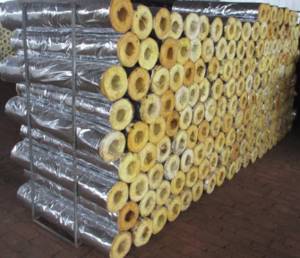
Photo: russian.alibaba.com
Glass wool is resistant to fire, so it is optimally placed in wooden buildings.
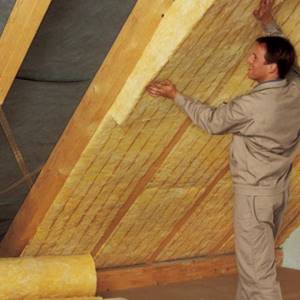
Photo: krasnodar.tiu.ru
Mineral wool protects well from dampness if it is chosen correctly: it should be a dense wall material for outdoor use, with moisture-proof impregnation. If these conditions are met, it does not interfere with the normal circulation of air and steam, while moisture does not accumulate inside it, the material does not become damp, and condensation almost does not occur in the premises.
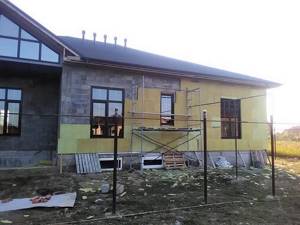
Photo: Instagram fasade_maykop
Cotton wool is also fire resistant and does not release toxins when heated. There are acoustic species that exhibit a good sound barrier.
There is, perhaps, only one downside: there are questions about the environmental friendliness of the material. Although it is in small quantities, it releases phenol-formaldehyde resins. Rospotrebnadzor claims that in a minimum dose they are harmless, but some people still prefer other insulation materials.
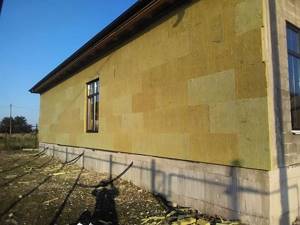
Photo: Instagram fasade_maykop
Polyurethane foam
The chemical composition is similar to foam rubber, but it is produced in liquid form. They began to use it in decoration recently. It has all the above positive properties of other thermal insulation materials. In addition, rodents and insects do not perceive it. And due to the absence of joints, the protective properties are excellent. PPU is also credited with excellent adhesion to almost any surface.
But to ensure that the characteristics of the material do not deteriorate, it is necessary to strictly follow the application technology, and this is not always easy.
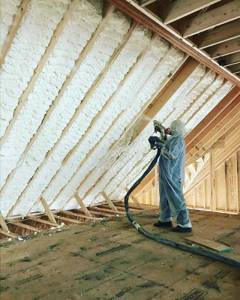
Photo: Instagram uteplenie_ppu_krasnodar
Article continues after advertisement
Cellulose
It is called ecowool because it consists of 80% recycled waste paper impregnated with an antiseptic - boric acid. It also contains fire retardants to reduce the level of flammability. Thermal conductivity is identical to other types of wool.

Photo: extrawool.ru
However, cellulose absorbs water, and if the installation technology is violated, its properties will deteriorate. In addition, it is very loose and inconvenient to work with. In terms of durability, like any natural material, it may be inferior to “synthetics”.
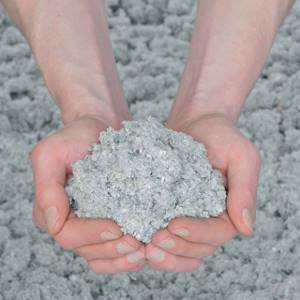
Photo: Instagram ekovatatomsk
Installation of insulation
Thermal insulation work on the outside of the building consists of the following stages:
- Preparation of materials.
- Preparing walls for installation.
- Carrying out installation work.
- Preparing walls for plastering.
- Reinforcement.
To understand each stage, let's look at them in more detail.
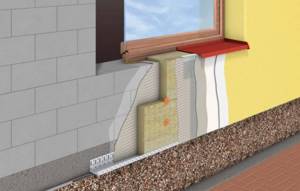
Material preparation process
To perform thermal insulation of facades under plaster, the following should be provided in advance:
- the presence of façade insulation of appropriate thickness. Basically, for basalt wool this figure should be from 10 cm. For colder regions from 15 cm;
- glue solution. It is necessary to choose a product taking into account the type of insulation. For mineral wool, this is a dry mixture of Ceresit CT180; for EPS, adhesive foam is used; for polystyrene foam, other appropriate compositions are used;
- guide strips for heat insulation slabs;
- dowels;
- façade primer;
- fiberglass mesh;
- perforated corners.
When choosing insulation, you should remember that among the important criteria, experts identify three characteristics of the material:
- density;
- fire safety;
- vapor permeability.

Preparing walls for installation
In order to prepare the walls for installation of insulation, the following requirements must be taken into account:
- Dismantle canopies, gutters and other parts that impede the work on residential buildings.
- Remove old plaster to avoid peeling after insulating the facade.
- Remove all dust and dirt from the cleaned wall. This can be done with water and a rag.
- Prime the walls. This must be done evenly, in two layers.
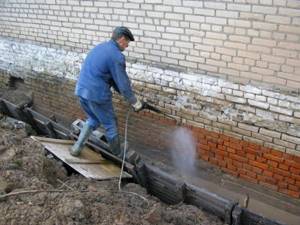
Installation of heat insulator
This is the most time-consuming and important part of the work, which is performed in several stages:
- It is necessary to secure the base strip. It is attached to the bottom of the wall, since this is where the external insulation begins. To install it, it is necessary to provide for the use of a building level.
- Prepare the adhesive solution. If the glue is presented in the form of a dry mixture, then it must be poured into a bucket and mixed with the volume of water indicated on the package. Until it resembles a dough-like consistency.
- Spread the glue evenly over the basalt slab. For smooth walls, a thin layer over the entire area of the sheet is sufficient. If the walls are uneven, apply the glue in lumps.
- Then carefully install the insulation board into the connector of the plinth strip and press it slightly against the wall surface. Use a level for leveling. Using this technology, it is necessary to glue the insulation along the entire first row.
- To ensure the correct placement of vertical joints, installation of the next row must begin with half of the slab. Using the same principle as when laying bricks.
- Having completed the thermal insulation of the facade, insulation of the slopes should be carried out. To complete this step, you must use an insulation board no more than 20 mm thick.
- Wait until the glue dries and begin attaching the dowels. This does not require significant effort and skill; it is enough to drill a hole through the insulation into the wall to the depth of the dowel itself, install it in the drilled hole and hammer a nail. In this case, one of the main points is the correct location of the fasteners. They must be installed in each of the four corners of the slab. They also need to be recessed a little into the slab so that the cap does not interfere with subsequent finishing work.
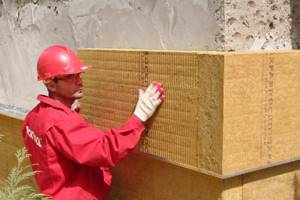
The process of preparing the facade for plastering
To properly plaster insulated walls, you must strictly follow the instructions:
- Eliminate all existing cracks by filling them with small pieces of insulating boards or sealing them with adhesive foam.
- If differences or any irregularities are detected on the surface of the walls, they should be carefully removed using a construction float or sandpaper.
- When using extruded polystyrene foam, the surface of the material must be rough. To give the insulation the desired roughness, it is enough to use a grater, a metal brush or a needle roller.
- Prime the walls. To do this, you need to use an adhesive primer, applying it in two layers.
- Install perforated corners on all corners of the house. Make sure that the corners are installed evenly; check their level.
- Using a putty knife, coat the fasteners with putty or glue.
After completing this work, the surface of the walls should be flat and smooth.

Reinforcement
The next stage is the rough finishing of the facade heat insulator. First of all, slopes are reinforced according to the following principle:
- The fiberglass mesh is cut taking into account the wrapping of the poles at the corners, so that they could overlap each other by about 10 cm.
- Next, an adhesive solution is applied to the slopes, the thickness of which should be about 0.4 mm.
- After applying the glue, the mesh must be applied to the slope treated with glue, level its surface, smoothing it with a spatula. Align the corners carefully. To give elasticity to a rigid mesh, just apply glue to it and wait a few minutes until it gets wet.
- The entire opening is reinforced in the same way.

Plaster
When choosing facade plaster for insulation, you must first analyze its vapor permeability. Also, the correct choice depends on the material on which it will be applied (mineral wool or expanded polystyrene). For mineral wool, it is best to use a vapor-permeable adhesive and plaster composition to avoid the accumulation of condensation in the insulation. For polystyrene foam, you can use any type of plaster.
Decorative plaster according to the following rules:
- The walls are first primed.
- Dry plaster is diluted in precise dosage. For these purposes, you can use a mixer or drill at minimum speed. The result should be a creamy mass.
- Using a spatula or a trowel, decorative plaster is applied to the walls in thin layers.
- Grout. After 6-8 minutes, when the plaster dries, it must be rubbed off. For this purpose, malka is used. Thanks to this, a certain texture of the wall surface is achieved.
- After the plaster has completely dried, it is completely painted and primed. Facade paint is applied in at least two layers. This allows you to achieve a better result.
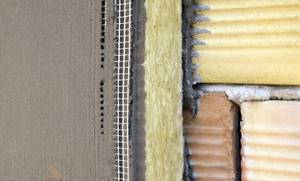
Thanks to insulating the walls of the house with basalt wool and subsequent plastering, it is easy to achieve effective energy saving of the entire building. Proper execution of the work and selection of high-quality materials will minimize the cost of finishing the facade and make your home cozy for many years.
Basalt heat insulator - pros and cons
High-quality basalt-based mineral wool has many advantages, among which especially noteworthy:
- Freely withstands high temperatures.
- During heating, mineral insulation does not emit dangerous toxic substances.
- Has good resistance to stains.
- Convenient to transport.
- Has a long service life. Basalt heat insulator can last more than fifty years, and during this time it will not lose its properties.
- It has a low level of sound conductivity. This property allows you to dampen excess acoustic vibrations.
- Basalt insulation has a good level of vibration resistance, which cannot be said about mineral wool.
- Stone wool does not belong to the line of explosive materials, so this type of insulation can be freely used to create thermal insulation for aggressive and hot environments.
- The material is not afraid of rodents.
- The basalt slab has a low specific gravity and yet has a high level of insulation.
- Due to its structure, stone wool has excellent resistance to any mechanical stress. And the point here is the arrangement of the fibers, they are in different directions, which ensures good rigidity of the heat insulator and also has a better effect on its practical properties.
- The material has excellent water-repellent qualities. Slab mineral stone wool can allow moisture to pass through, but it does not accumulate inside the material.
Characteristics of basalt insulation However, despite its many advantages, stone wool has its disadvantages:
- The cost of a basalt heat insulator is quite high, which ranks this type of heat insulator among the line of preferred materials.
- Slab basalt insulation at the joints has a large number of seams, which, when laying it, may cause some important thermal insulation properties to be somewhat reduced.
- Strength characteristics also cannot boast of high indicators.
- Many experts argue that the use of a phenolic substance as a binder during foam production makes the insulation environmentally unsafe.
Read with this
- Roll insulation: soft and self-adhesive, plate or rolls, thermal insulation for walls 150 mm, types and properties of thermal insulation materials
- Insulating walls with mineral wool from the inside: pros and cons, expert advice
- How to insulate an aerated concrete house from the outside?
- Proper insulation of walls from the inside of a private house with your own hands in several ways
- Glass wool
- Which insulation is best for an attic roof: 7 best options
- Do-it-yourself attic floor insulation
- Insulation dimensions
- Do-it-yourself insulation of a sauna from the inside using different materials
- Features of the technology of wall insulation with mineral wool
Selecting a thermal insulator
Basalt mineral wool
This heat insulator is one of the natural insulation materials. Silicate rocks and metallurgical slag are used for its production. When the raw material is melted and drawn out, a material is obtained consisting of porous fibers, which are used to form thermal insulation boards.
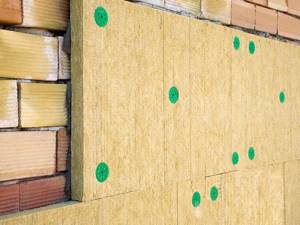
The advantages of insulation include:
- Possibility of use with any type of surface;
- naturalness, since it is made from environmentally friendly raw materials;
- vapor permeability;
- high sound insulation;
- resistance to chemical reactions;
- resistance to rodents and pests;
- fire safety.
Among the disadvantages are:
- gyroscopicity. This type of insulation easily absorbs water. To eliminate this factor, impregnation is carried out using various types of water-repellent compounds;
- due to its low density, it is difficult to install; appropriate qualifications are required for correct installation;
- may become deformed or shrink over time;
- to perform effective thermal insulation it is necessary to use a decent layer of insulation - more than 10 cm;
- may cause harm to health. To avoid this, protective clothing should be worn.
For insulation of a building and its subsequent plastering, the use of two-layer basalt wool slabs is considered optimal. Thus, the use of soft layers makes it possible to hide the unevenness of the walls, and hard materials with a density of more than 130 kg/m3 make it possible to easily apply glue and plaster.
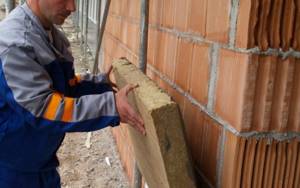
Foam plastic - material for inexpensive thermal insulation
This heat insulator is a rigid plate, the structure of which is made of foamed polystyrene granules soldered to each other. Polystyrene foam has the following advantages:
- low cost. It is one of the most inexpensive insulation materials;
- has low thermal conductivity;
- lightweight, has little mass;
- environmental friendliness. The material does not pose a threat to human health;
- moisture resistant;
- not subject to deformation;
- has resistance to fungal formations and mold;
- easy to adjust and install, without the use of special tools and appropriate
- qualifications.
At the same time, polystyrene foam also has a number of significant disadvantages:
- has high vapor permeability;
- has increased fragility;
- susceptible to combustion, melts easily, releasing toxic fumes;
- when exposed to ultraviolet rays it is destroyed;
- may react with products that contain bitumen;
- susceptible to rodents and other pests;
- Installed exclusively on a flat wall surface.
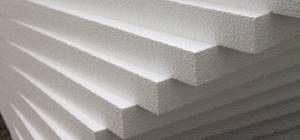
Foam plastic facade insulation for plaster includes the brands PSB-S25F, PSB-S35F. They have a density from 15 to 35 kg/m3. This is a self-extinguishing material, thanks to antiprenes, in the event of combustion, all flammable processes are suppressed in 4-5 seconds.
Extruded polystyrene foam
This material is an advanced polystyrene foam. For its production, polystyrene granules are used, which are foamed in high-temperature chambers. The resulting mass is extruded through an extruder. The result is dense and durable slabs. EPPS has a finely porous, monolithic structure that is not subject to disintegration into granules.
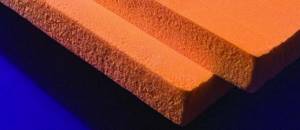
EPS is much more practical than conventional foam plastic and has the lowest thermal conductivity coefficient among existing thermal insulators. Therefore, you can use even a thin layer of material; it will be enough to effectively insulate the walls. According to other characteristics, it is similar to polystyrene foam, but has a higher cost. For plastering facades, the material used is Penoplex 35 or Penoplex facade. They are quite durable and have increased fire safety.

